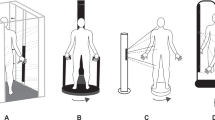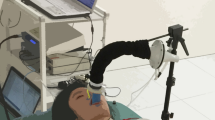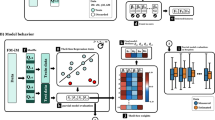Abstract
OBJECTIVE: To determine and compare the extent of within- and between-laboratory precision in body volume (BV) measurements using air displacement plethysmography (ADP), the BOD POD body composition system, and to interpret any such variability in terms of body composition estimates.
DESIGN: Repeated test procedures of BV assessment using the BOD POD ADP were reproduced at two laboratories for the estimation of precision, both within and between laboratories.
SUBJECTS: In total, 30 healthy adult volunteers, 14 men (age, 19–48 y; body mass index (BMI), 19.7–30.3 kg/m2) and 16 women (age, 19–40 y; BMI, 16.3–35.7 kg/m2), were each subjected to two test procedures at both laboratories. Two additional volunteers were independently subjected to 10 repeated test procedures at both laboratories.
MEASUREMENTS: Repeated measurements of BV, uncorrected for the effects of isothermal air in the lungs and the surface area artifact, were obtained using the BOD POD ADP, with the identical protocol being faithfully applied at both laboratories. Uncorrected BV measurements were adjusted to give estimates of actual BV that were used to calculate body density (body weight (BWt)/actual BV) from which estimates of body composition were derived. The differences between repeated BV measurements or body composition estimates were used to assess within-laboratory precision (repeatability), as standard deviation (SD) and coefficient of variation; the differences between measurements reproduced at each laboratory were used to determine between-laboratory precision (reproducibility), as bias and 95% limits of agreement (from SD of the differences between laboratories).
RESULTS: The extent of within-laboratory methodological precision for BV (uncorrected and actual) was variable according to subject, sample group and laboratory conditions (range of SD, 0.04–0.13 l), and was mostly due to within-individual biological variability (typically 78–99%) rather than to technical imprecision. There was a significant (P<0.05) bias between laboratories for the 10 repeats on the two independent subjects (up to 0.29 l). Although no significant bias (P=0.077) was evident for the sample group of 30 volunteers (−0.05 l), the 95% limits of agreement were considerable (−0.68 to 0.58 l). The effects of this variability in BV on body composition were relatively greater: for example, within-laboratory precision (SD) for body fat as % BWt was between 0.56 and 1.34% depending on the subject and laboratory; the bias (−0.59%) was not significant between laboratories, but there were large 95% limits of agreement (−3.67 to 2.50%).
CONCLUSION: Within-laboratory precision for each BOD POD instrument was reasonably good, but was variable according to the prevailing conditions. Although the bias between the two instruments was not significant for the BV measurements, implying that they can be used interchangeably for groups of similar subjects, the relatively large 95% limits of agreement indicate that greater consideration may be needed for assessing individuals with different ADP instruments. Therefore, use of a single ADP instrument is apparently preferable when assessing individuals on a longitudinal basis.
This is a preview of subscription content, access via your institution
Access options
Subscribe to this journal
Receive 12 print issues and online access
$259.00 per year
only $21.58 per issue
Buy this article
- Purchase on Springer Link
- Instant access to full article PDF
Prices may be subject to local taxes which are calculated during checkout


Similar content being viewed by others
References
McCrory MA, Gomez TD, Bernauer EM, Mole PA . Evaluation of a new air displacement plethysmograph for measuring human body composition. Med Sci Sports Exerc 1995; 27: 1686–1691.
Dempster P, Aitkens S . A new air displacement method for the determination of human body composition. Med Sci Sports Exerc 1995; 27: 1692–1697.
Biaggi RR, Vollman MW, Nies MA, Brener CE, Flakoll PJ, Levenhagen DK, Sun M, Karabulut Z, Chen KY . Comparison of air-displacement plethysmography with hydrostatic weighing and bioelectrical impedance analysis for the assessment of body composition in healthy adults. Am J Clin Nutr 1999; 69: 898–903.
Collins MA, Millard-Stafford ML, Sparling PB, Snow TK, Rosskopf LB, Webb SA, Omer J . Evaluation of the BOD POD for assessing body fat in collegiate football players. Med Sci Sports Exerc 1999; 31: 1350–1356.
Demerath EW, Guo SS, Chumlea WC, Towne B, Roche AF, Siervogel RM . Comparison of percent body fat estimates using air displacement plethysmography and hydrodensitometry in adults and children. Int J Obes Relat Metab Disord 2002; 26: 389–397.
Dewit O, Fuller NJ, Fewtrell MS, Elia M, Wells JCK . Whole body air displacement plethysmography compared with hydrodensitometry for body composition analysis. Arch Dis Child 2000; 82: 159–164.
Fields DA, Wilson GD, Gladden LB, Hunter GR, Pascoe DD, Goran MI . Comparison of the BOD POD with the four-compartment model in adult females. Med Sci Sports Exerc 2001; 33: 1605–1610.
Levenhagen DK, Borel MB, Welch DC, Piasecki JH, Piasecki DP, Chen KY, Flakoll PJ . A comparison of air displacement plethysmography with three other techniques to determine body fat in healthy adults. JPEN 1999; 23: 293–299.
Millard-Stafford ML, Collins MA, Evans EM, Snow TK, Cureton KJ, Rosskopf LB . Use of air displacement plethysmography for estimating body fat in a four-component model. Med Sci Sports Exerc 2001; 33: 1311–1317.
Nunez C, Kovera AJ, Pietrobelli A, Heshka S, Horlick M, Kehayias JJ, Wang Z, Heymsfield SB . Body composition in children and adults by air displacement plethysmography. Eur J Clin Nutr 1999; 53: 382–387.
Sardinha LB, Lohman TG, Teixeira PJ, Guedes DP, Going SB . Comparison of air displacement plethysmography with dual-energy X-ray absorptiometry and 3 field methods for estimating body composition in middle-aged men. Am J Clin Nutr 1998; 68: 786–793.
Wagner DR, Heyward VH, Gibson AL . Validation of air displacement plethysmography for assessing body composition. Med Sci Sports Exerc 2000; 32: 1339–1344.
Fields DA, Goran MI . Body composition techniques and the four-compartment model in children. J Appl Physiol 2000; 89: 613–620.
Lockner DW, Heyward VH, Baumgartner RN, Jenkins KA . Comparison of air displacement plethysmography, hydrodensitometry, and dual-energy X-ray absorptiometry for assessing body composition of children 10 to 18 years of age. Ann NY Acad Sci 2000; 904: 72–78.
Fields DA, Goran MI, McCrory MA . Body-composition assessment via air-displacement plethysmography in adults and children: a review. Am J Clin Nutr 2002; 75: 453–467.
Siri WE . Body composition from fluid spaces and density: analysis of methods. In: Brozek J, Henschel A (eds) Techniques for measuring body composition. National Academy of Sciences, National Research Council: Washington, DC; 1961. pp 223–244.
McCrory MA, Mole PA, Gomez TD, Dewey KG, Bernauer EM . Body-composition by air-displacement plethysmography by using predicted and measured thoracic gas volumes. J Appl Physiol 1998; 84: 1475–1479.
Wells JCK, Fuller NJ . Precision of measurement and body size in whole-body air-displacement plethysmography. Int J Obes Relat Metab Disord 2001; 25: 1161–1167.
Collins AL, McCarthy HD . Evaluation of factors determining the precision of body composition measurements by air-displacement plethysmography. Eur J Clin Nutr 2003; 57: 770–776.
British Standards Institution. Precision of test methods. Part 1: Guide for the determination and reproducibility for a standard test method (BS5497, part 1). BSI: London; 1979.
Bland JM, Altman DG . Statistical methods for assessing agreement between two methods of clinical measurement. Lancet 1986; I: 307–310.
Withers RT, LaForgia J, Heymsfield SB . Critical appraisal of the estimation of body composition via two-, three-, and four-compartment models. Am J Hum Biol 1999; 11: 175–185.
Gnaedinger RH, Reineke EP, Pearson AM, Van Huss WD, Wessel JA, Montoye HJ . Determination of body density by air displacement, helium dilution, and underwater weighing. Ann NY Acad Sci 1963; 110: 96–108.
Gundlach BL, Visscher GJW . The plethysmometric measurement of total body volume. Hum Biol 1986; 58: 783–799.
Vescovi JD, Zimmerman SL, Miller WC, Hildebrandt L, Hammer RL, Fernall B . Evaluation of the BOD POD for estimating percentage body fat in a heterogeneous group of adult humans. Eur J Appl Physiol 2001; 85: 326–332.
Durnin JVGA, Taylor A . Replicability of measurements of density of the human body as determined by underwater weighing. J Appl Physiol 1960; 15: 142–144.
Mendez J, Lukaski HC . Variability of body density in ambulatory subjects measured at different days. Am J Clin Nutr 1981; 34: 78–81.
Going SB . Densitometry. In: Roche AF, Heymsfield SB, Lohman TG (eds). Human body composition. Human Kinetics Publishers: Champaign, IL; 1996. pp 3–21.
Deurenberg P, Westerterp KR, Velthuis-Te Wierik EJM . Between-laboratory comparison of densitometry and bio-electrical impedance measurements. Br J Nutr 1994; 71: 309–316.
Lohman TG . Advances in body composition assessment. Current issues in exercise science, Monograph number 3. Human Kinetic Publishers: Champaign, IL; 1992.
Brozek J, Grande F, Anderson JT, Keys A . Densitometric analysis of body composition: revision of some quantitative assumptions. Ann NY Acad Sci 1963; 110: 113–140.
Weyers AM, Mazzetti SA, Love DM, Gomez AL, Kraemer WJ, Volek JS . Comparison of methods for assessing body composition changes during weight loss. Med Sci Sports Exerc 2002; 34: 497–502.
Fuller NJ, Jebb SA, Laskey MA, Coward WA, Elia M . Four-component model for the assessment of body composition in humans: comparison with alternative methods, and evaluation of the density and hydration of fat-free mass. Clin Sci 1992; 82: 687–693.
Wells JCK, Fuller NJ, Dewit O, Fewtrell MS, Elia M, Cole TJ . Four-component model of body composition in children: density and hydration of fat-free mass and comparison with simpler models. Am J Clin Nutr 1999; 69: 904–912.
Acknowledgements
We thank Deborah Ridout of the Centre for Paediatric Epidemiology and Biostatistics, Institute of Child Health, 30 Guilford Street, London WC1N 1EH, for expert statistical advice.
Author information
Authors and Affiliations
Corresponding author
Rights and permissions
About this article
Cite this article
Collins, A., Saunders, S., McCarthy, H. et al. Within- and between-laboratory precision in the measurement of body volume using air displacement plethysmography and its effect on body composition assessment. Int J Obes 28, 80–90 (2004). https://doi.org/10.1038/sj.ijo.0802466
Received:
Revised:
Accepted:
Published:
Issue Date:
DOI: https://doi.org/10.1038/sj.ijo.0802466
Keywords
This article is cited by
-
Estimation of Human Body Volume (BV) from Anthropometric Measurements Based on Three-Dimensional (3D) Scan Technique
Aesthetic Plastic Surgery (2017)
-
Interdevice variability in percent fat estimates using the BOD POD
European Journal of Clinical Nutrition (2005)



